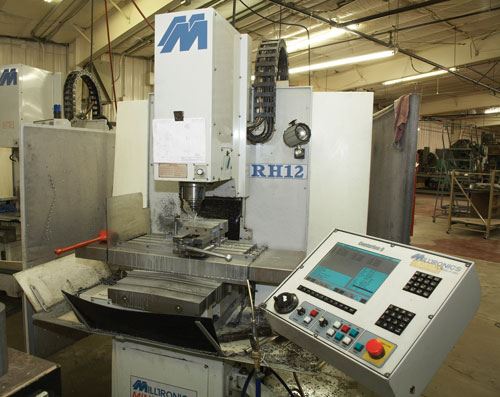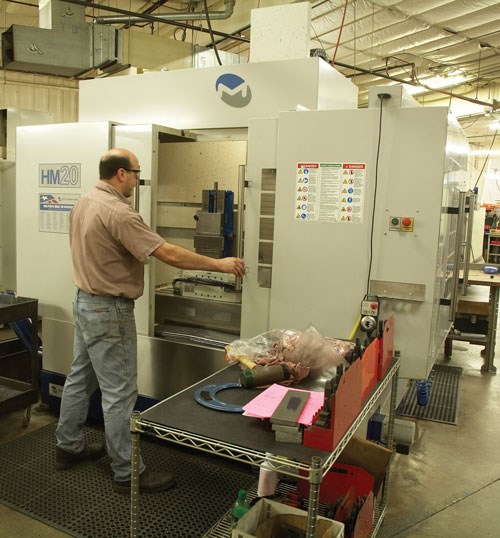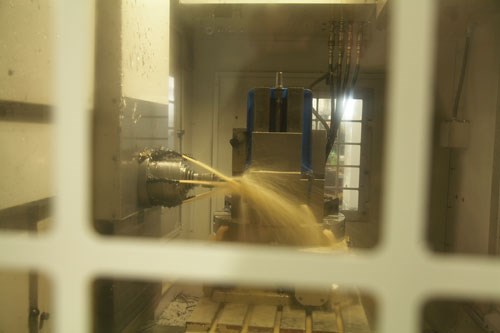Milling, Turning Machine Line Supports Versatility
This shop relies almost exclusively on Milltronics machines for its milling and turning operations. The machines’ easy-to-use, conversational control, reliability and capacity for tight tolerances help support the versatility the shop needs to stay competitive.
Share



During the past 30 years, George Ziaja has become well-known in the Milwaukee area for his ability to solve tough process improvement problems. That personal reputation has also become a hallmark of his shop, Ziaja Machining Corporation (ZMC). The shop touts a track record of not only producing quality parts, but also aiding customers in revamping product designs to improve productivity and cut costs.
With few repeat jobs, Mr. Ziaja and his employees get plenty of chances to exercise their penchant for problem solving. While this keeps the shop busy, pursuing such a wide variety of work also presents challenges. Flexibility is key to maintaining a competitive edge, and for that, the shop relies in large part on its fleet of Milltronics turning and milling machines and their conversational controls.
Based in Plymouth, Wisconsin, ZMC is a hybrid—a mix of low-volume production machining and tool and die making. The shop specializes in stainless steel and plastics. Components for the food industry, especially sausage- and cheese-making enterprises, constitute approximately 60 percent of its business. The rest consists of a smattering of components for machines in other industries, including laser cutters, printing machines and machines used to produce such paper products as diapers and toilet-paper.
Mr. Ziaja, the company’s founder, has worked in the industry since he was 16 years old. After completing his apprenticeship at the machine shop where he spent the early part of his career, he learned to work in virtually every position and to operate virtually every piece of equipment. He eventually moved into a supervisory role and went on to become general manager/sales. As that shop’s focus shifted to large, commercial accounts, he saw an opportunity to launch his own company to target smaller businesses—accounts that would be inclined to form a partnership and grow together. Since 1995, ZMC has done just that, and the majority of its new business comes from customer referrals.
In a single day on ZMC’s shop floor, one might see machine guides for laser cutter components being machined; steel tables being fabricated and welded for a food processing customer; plastic bearing sleeves being processed on a cylindrical grinder; sausage stuffing horns being turned on a lathe; angle plates for a diaper-making machine being milled and drilled on an HMC; and food-grade plastic paddles for the cheese industry being refurbished. To take on such a variety of jobs, the shop’s 28 employees use a full range of grinders, presses, saws, hobs and welders. The bulk of the milling and turning work falls to 14 machines from Milltronics (Waconia, Minnesota), a supplier upon which ZMC has relied almost exclusively for the past 13 years.
A prime reason for that commitment is the easy-to-use, conversational programming included in these machines’ CNCs. At ZMC, programming from the shop floor is more practical than using a CAM system, which would be both costly and insufficient for supporting the versatility necessary to keep up with its variety of work, Mr. Ziaja says. "With the volume of parts we turn out every day, I would need two or three dedicated programmers," he explains. "Some jobs take maybe 15 minutes or a half hour, and these controls are so easy to program that we could have two or three of those done before a CAM programmer could get even one job out to the floor. For those jobs that do repeat, we can store the programs offline and reuse them when we need to."
Through a menu-based question-and-answer format, the CNC prompts the operator for job information and automatically creates the program at the machine from the entered data. The use of Auto Routines enables operators to program without knowledge of G or M codes, while a "Trig Help" feature eliminates the need for shopfloor calculations. The interface is designed to minimize keystrokes to avoid potential typos and missed operations. Also, programs can be edited and multiple tasks can be accomplished form a single screen. "You don’t have to go through a lot of different menus; it’s all right there in front of you on one screen," Mr. Ziaja says. "With other conversational controls I’ve used, sometimes you have to go to a page ahead or a page back, so the Milltronics control is much easier."
He adds that another benefit of standardizing on Milltronics is that all the controls use the same basic interface, which eases the training of new hires. "I can send practically any operator to any of the machines. The lathe operations are a little different from the HMCs and VMCs, but it’s basically the same control, so it doesn’t take too long to train anyone."
The control’s verification features also come in handy, Mr. Ziaja says. In addition to a graphical representation of the tool proceeding along the programmed paths, which helps the shop ensure accuracy and avoid collisions or other problems, verification is especially useful for estimating the time it will take to perform any given job. "I was out of town recently, and on my way back, I called my son and said ‘put this print in there and see how long it’ll take for this part to run,’" he recalls. "He called me back in about five minutes with an answer."
Intuitive programming could go only so far if the machine itself weren’t sufficiently accurate, but that’s not a problem at ZMC. The shop routinely machines parts to tolerances as tight as ±0.0002 inch. Additionally, Mr. Ziaja says the machines are reliable enough for him to expect almost 100-percent productivity from each model. "They’re well-built, and unscheduled downtime is insignificant," he notes. "In fact, we still have our original MC20, which dates back to 1997. We call it ‘The Beast,’ and it can still be a workhorse."
The most recent additions to the shop’s Milltronics family include an RH33 and an RW18, both VMCs, as well as an ML18 combination lathe. These machines were incorporated after the shop bought out another nearby company. The timing was fortuitous, as the shop has recently begun to take on more large, fabricated parts that need to be milled and drilled as well as higher-volume turning work (that is, 100 to 200-piece runs).
The RH33 VMC has been invaluable for large work, Mr. Ziaja says. With X-, Y- and Z-axis travels of 78 × 33 × 28 inches, the machine is the biggest on the floor. It enables the shop to machine longer parts in one setup, rather than shifting them within the work envelope or moving them to a different machine. Likewise, the ML18’s automatic turret—an option the shop’s other ML18 lacks—improves productivity for the new turning jobs.
The next time the shop seeks to expand its range of machines and capabilities, it will likely turn again to Milltronics, Mr. Ziaja says. "The machines are priced reasonably, reliable and easy to program."
Related Content
Okuma HMC Provides Enhanced Cybersecurity, Versatility
Okuma America Corp. introduces the MA-4000H CNC horizontal machining center, designed with embedded cybersecurity features and “sludgeless tank” chip and coolant management technology.
Read MoreDN Solutions America Unveils Impressive Chicago Technical Center at IMTS 2024
New tech center is serving as a cutting-edge showroom and a technological hub for advanced machining applications.
Read MoreDN Solutions Acquires Heller to Boost Global Machine Tool Market Presence
DN Solutions integrates Heller Group, leveraging a 130-year legacy to enhance machining center technology and expand customer reach.
Read More4+2 Machining Cuts Cycle Times From Days to Minutes
By moving from legacy jig bores and tilt tables to a milling and boring machine, Highland Manufacturing cut cycle times from days to minutes on high-tolerance, large-diameter parts.
Read More































.png;maxWidth=300;quality=90)




